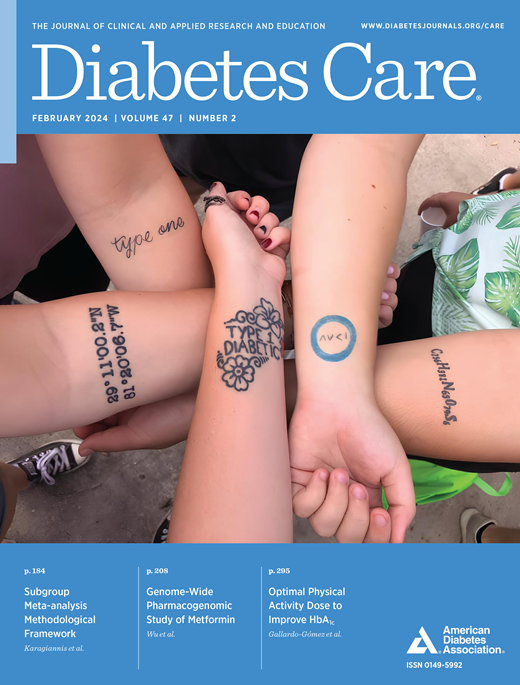2016-2021年美国亚洲妊娠糖尿病患者不良妊娠结局风险分析
IF 16.6
1区 医学
Q1 ENDOCRINOLOGY & METABOLISM
引用次数: 0
摘要
目的 患有妊娠期糖尿病(GDM)的不同种族和民族群体发生不良妊娠结局(APO)的风险不同。将这些群体汇总在一起可能会掩盖不良妊娠结局的异质性。我们评估了亚洲 GDM 患者群体中 APOs 的频率和风险是否存在差异。研究设计和方法 这是一项对美国出生证明数据(2016-2021 年)的连续横断面分析,数据来自第一胎活产的单胎婴儿。研究对象是自我报告的产妇种族和民族,以亚裔印度人、中国人、菲律宾人、日本人、韩国人和越南人与非西班牙裔白人为参照。孕产妇结局包括:初次剖宫产、妊娠高血压疾病(HDP)、入住重症监护室和输血。新生儿结局包括胎龄大(LGA)、胎龄小(SGA)、早产和入住新生儿重症监护室(NICU)。结果 研究人群包括 29,370 名印度人、16,146 名中国人、9,082 名菲律宾人、6,497 名越南人、3,754 名韩国人和 1,253 名日本人,以及 254,433 名白人。在 2016 年至 2021 年期间,大多数亚洲群体的 HDP 发生率都有所上升,但其他 APO 的发生率并没有上升。在多变量分析中,与白人相比,所有亚裔群体中的个体发生 SGA 的可能性较高,而发生 LGA 的可能性较低。对其他 APOs 的研究结果也不尽相同。在亚洲群体中,菲律宾人患 APOs 的风险通常最高,其次是印度人,而华人患 APOs 的风险最低。有必要在糖尿病与妊娠研究和监测中对亚裔人群进行分类,以确定干预的机会。本文章由计算机程序翻译,如有差异,请以英文原文为准。
Risk of Adverse Pregnancy Outcomes Among Asian Individuals With Gestational Diabetes Mellitus in the U.S., 2016–2021
OBJECTIVE The risk of adverse pregnancy outcomes (APOs) differs among race and ethnic groups with gestational diabetes mellitus (GDM). Heterogeneity in APOs may be masked by aggregating these groups. We assessed whether the frequency and risk of APOs differed among Asian groups with GDM. RESEARCH DESIGN AND METHODS This is a serial cross-sectional analysis of U.S. birth certificate data (2016–2021) from individuals with a singleton first livebirth. The exposure was self-reported maternal race and ethnicity stratified by Asian Indian, Chinese, Filipino, Japanese, Korean, and Vietnamese versus non-Hispanic White as the reference. Maternal outcomes included: primary cesarean delivery, hypertensive disorders of pregnancy (HDP), intensive care unit admission, and transfusion. Neonatal outcomes included large-for-gestational-age (LGA), small-for-gestational-age (SGA), preterm birth, and neonatal intensive care unit (NICU) admission. RESULTS The study population included 29,370 Indian, 16,146 Chinese, 9,082 Filipino, 6,497 Vietnamese, 3,754 Korean, and 1,253 Japanese individuals, and 254,433 White individuals. Between 2016 and 2021, the frequency of HDP, but not other APOs, increased among most Asian groups. In multivariable analyses, individuals in all Asian groups had higher likelihood of SGA and lower likelihood of LGA compared with White individuals. Findings for other APOs were heterogeneous. The risk of APOs was generally highest among Filipino individuals, followed by Indian individuals, and lowest among Chinese individuals among Asian groups. CONCLUSIONS There was significant heterogeneity in the frequency and risk of APOs among Asian individuals with GDM in the U.S. Disaggregation of the Asian population in diabetes and pregnancy research and surveillance is necessary to identify opportunities for intervention.
求助全文
通过发布文献求助,成功后即可免费获取论文全文。
去求助
来源期刊

Diabetes Care
医学-内分泌学与代谢
CiteScore
27.80
自引率
4.90%
发文量
449
审稿时长
1 months
期刊介绍:
The journal's overarching mission can be captured by the simple word "Care," reflecting its commitment to enhancing patient well-being. Diabetes Care aims to support better patient care by addressing the comprehensive needs of healthcare professionals dedicated to managing diabetes.
Diabetes Care serves as a valuable resource for healthcare practitioners, aiming to advance knowledge, foster research, and improve diabetes management. The journal publishes original research across various categories, including Clinical Care, Education, Nutrition, Psychosocial Research, Epidemiology, Health Services Research, Emerging Treatments and Technologies, Pathophysiology, Complications, and Cardiovascular and Metabolic Risk. Additionally, Diabetes Care features ADA statements, consensus reports, review articles, letters to the editor, and health/medical news, appealing to a diverse audience of physicians, researchers, psychologists, educators, and other healthcare professionals.
 求助内容:
求助内容: 应助结果提醒方式:
应助结果提醒方式:


